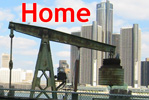

  |
Visteon Corporation was spun off from Ford Motor Company in June of 2000. Soon after, the world’s second-largest auto parts supplier began looking for a new home that would promote its corporate identity while consolidating 13 facilities in southeast Michigan.[1] It has found that home in Van Buren Township with the construction of Visteon Village, which combines creative financing methods, innovative architecture, and environmental sensitivity.
Visteon Village is the corporate headquarters and houses 3,200 employees. The site is 25 miles from Detroit and was selected partly due to its proximity to customers, other Visteon facilities, and the geographic center of their employee base. The nine buildings provide 800,000 square feet of offices, product innovation centers, testing facilities, design centers, and laboratories.[2]
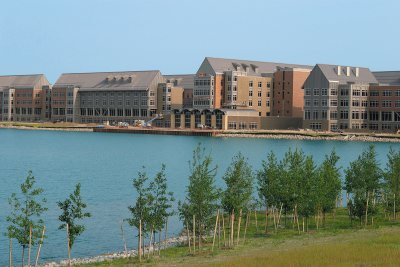 Constructed on an abandoned quarry, the 265-acre parcel includes a lake, wetlands, and walking trails, while only having development occur on 30 percent of the site. In addition to the 5,000 new trees planted on site, the structure was designed with minimal impact to the environment, including the use of recycled products and reuse of on-site materials.[3]
Constructed on an abandoned quarry, the 265-acre parcel includes a lake, wetlands, and walking trails, while only having development occur on 30 percent of the site. In addition to the 5,000 new trees planted on site, the structure was designed with minimal impact to the environment, including the use of recycled products and reuse of on-site materials.[3]
Visteon refined its search for suitable property with help from a Michigan Economic Development Corporation (MEDC) database of communities; the company was able to search for a community that met basic criteria such as a minimum 150-acre parcel with natural features, access to freeways, and flexibility to work with the company’s short timetable. Van Buren Township was further investigated after a call from a realtor. After visiting the site, and seeing how the project fit within the Township’s master plan, the company was convinced that Van Buren Township was a possible location for its $300 million project.[4]
Township officials received a detailed proposal from Visteon and created cross-functional teams to study the issues and prepare for the possibility of becoming home to a Fortune 500 company. The total state and local incentive package of $74 million, and qualitative issues of location and community preparedness, were enough to give Van Buren Township an advantage over four other municipalities.[5] The financing package used tools that are available to other Michigan municipalities. Equally as important to attracting new development are the non-tax benefits of working with a community like Van Buren Township.[6]
Van Buren Township updated their master plan and other planning documents in the late 1990s. McKenna Associates, worked with the Township planning department with the goals of creating a premier community that would attract economic development and provide for smart growth.[7] Specifically, Van Buren’s Haggerty-Ecorse Corridor Plan, which describes a vision for the growth of the property that surrounds the Visteon parcel, was a critical part of what attracted Visteon to Van Buren Township.[8]
Since Governor Granholm has a vision of making Michigan a magnet for high-tech jobs, and Visteon had considered a location in Toledo, Ohio, the State of Michigan provided an incentive package to the auto supplier. The MEDC sponsored a $15.7 million Single Business Tax Credit over 13 years and the Michigan Department of Transportation (MDOT) provided a $5 million grant for road improvements around the project. The State expects 800 new jobs and an increase to state revenues of $50 million because of Visteon’s commitment to Michigan.[9]
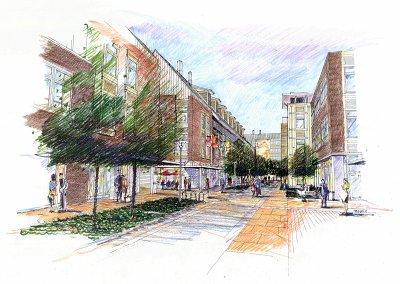 Van Buren Township also provided financial incentives to Visteon. A 12-year industrial facilities tax abatement cut the project’s property tax in half. The abatement should save Visteon $3.4 million in township taxes over that period. Van Buren Township provides abatements to companies through a point system that reflects job creation and environmental impact. Even with the abatement, it will be a net gain for the community, as the empty quarry only paid $3,500 in taxes and was proposed to become a non-taxed public park. Even with the abatement, Visteon will contribute more than $200,000 in tax revenues to the Township.[10]
Van Buren Township also provided financial incentives to Visteon. A 12-year industrial facilities tax abatement cut the project’s property tax in half. The abatement should save Visteon $3.4 million in township taxes over that period. Van Buren Township provides abatements to companies through a point system that reflects job creation and environmental impact. Even with the abatement, it will be a net gain for the community, as the empty quarry only paid $3,500 in taxes and was proposed to become a non-taxed public park. Even with the abatement, Visteon will contribute more than $200,000 in tax revenues to the Township.[10]
Additionally, a Local Development Finance Authority (LDFA) was created for the Visteon site. LDFAs are a form of tax increment financing (TIF) that is provided by Michigan Act 281 of 1986; there are currently about 100 of them in the state. The primary purpose of such an authority is to capture incremental tax revenue for infrastructure and public improvements that are necessary for industrial projects to move forward and to attract economic growth.[11] Typically, LDFAs have a finite life span, usually the length of time needed to complete and pay for improvements. The municipality must notify taxpayers in the proposed LDFA and submit information to other taxing bodies that may wish to opt out, such as libraries and community colleges. Once approved, a commission is appointed to create an incremental financing plan and begin allocating funds for improvements.[12]
Van Buren Township’s LDFA was established in July of 2002 and will expire in 2029. It extends beyond Visteon Village to include parcels that will likely be used for complementary uses to Visteon while including roads and intersections that require improvements. The LDFA board approved the sale of $29 million in bonds to pay for infrastructure improvements, including roadwork and other means to reduce traffic impacts, and various site preparations, including wetland conservation.[13] Twenty-two million dollars are earmarked for Visteon as repayments of site preparations done by their contractors.[14] All the improvements are paid for by the taxes on the Visteon property; the money is not coming from Township residents.[15]
One of the goals in the design of Visteon Village was to create an environment that encourages creativity and collaboration.[16] Unlike traditional corporate campuses spread out in industrial-style buildings, Visteon Village is designed to look like a traditional Main Street in a small European village, complete with cobblestone streets and buildings that resemble historic downtown structures, none of which is more than four stories tall.[17]
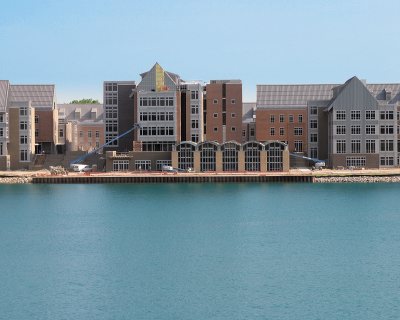 Depending on the functional unit housed in a building, the architecture might resemble more residential for offices, or more retail for testing and design. Inside is more open than traditional office buildings, with only 20 private offices. Open workstations allow for increased free-exchange of ideas. The nine buildings are linked through underground tunnels for the cold Michigan winters, but during the summer, employees can walk outside along landscaped walkways reminiscent of a New England town, or use the nature paths on the property.[18]
Depending on the functional unit housed in a building, the architecture might resemble more residential for offices, or more retail for testing and design. Inside is more open than traditional office buildings, with only 20 private offices. Open workstations allow for increased free-exchange of ideas. The nine buildings are linked through underground tunnels for the cold Michigan winters, but during the summer, employees can walk outside along landscaped walkways reminiscent of a New England town, or use the nature paths on the property.[18]
Main Street, as the pedestrian walkway between the buildings is known, includes benches and trees and access to retail stores such as a bank, dry cleaner, fitness center, barber shop, and restaurant, all of which are tenants in the Village. The buildings were designed to be less than 60 feet wide, with chimneys and dormer-covered roofs to complete the image of a small town.[19]
While an architecture firm was hired to design Visteon Village, many of the selections for materials and fixtures included Visteon employees. The company even produced the glass for the project at its auto glass plants.[20] Among the nine buildings, a variety of activities happen in varied spaces. A town hall is available for meetings of 800 employees at One Village Center, which overlooks the lake on the property. Other buildings have loft spaces with natural light for creative conferences or quiet discussions. First floor spaces allow for vehicle showrooms, much like retail space in a central business district.[21]
Employees who leave the buildings for outdoor meetings are treated to a sight that is far different from what was visible when Visteon purchased the property. In 2000, the site was an abandoned gravel quarry. It now has Grace Lake, a 37-acre man-made lake that the Village sits alongside, and 35 acres of wetland with almost a mile of nature trails. The trails are available to employees and the public. These trails were partly funded by county environmental grants for which Township officials applied; the remaining funding came from the LDFA. An additional wetland was created to filter storm runoff and remove pollutants from the site’s surface water.[22] All storm water is contained on site and native habitats for fish and other species were developed on the property.[23]
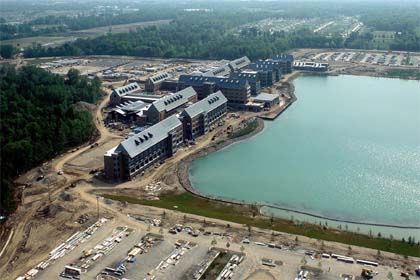 Additionally, Visteon Village was designed using the U.S. Green Building Council's Leadership in Energy and Environmental Design (LEED) guidelines. The guidelines provide sustainability goals for energy efficiency, water savings, and material usage. Building materials are 75 percent recycled content, and include roofs that reflect excessive summer heat, while the air handling system and organic interior materials provide high levels of indoor environmental quality. The lake is also part of the facility’s cooling system.[24]
Additionally, Visteon Village was designed using the U.S. Green Building Council's Leadership in Energy and Environmental Design (LEED) guidelines. The guidelines provide sustainability goals for energy efficiency, water savings, and material usage. Building materials are 75 percent recycled content, and include roofs that reflect excessive summer heat, while the air handling system and organic interior materials provide high levels of indoor environmental quality. The lake is also part of the facility’s cooling system.[24]
During site work, 75,000 tons of concrete were recycled and used for parking lot construction, while 168,000 cubic-yards of rubble were reused along the lake. Additionally, more than 400,000 cubic yards of earth were reused on site for landscaping berms and not hauled off to landfills. Trees and other landscaping combined with a fisheries project will make the former eyesore into an environmental trophy that is home to environmentally-friendly structures.[25]
While Van Buren Township did not seek out a specific major economic investment like Visteon Village, they were prepared when it came looking for a new place to call home. Good planning and continued communication have provided the community with a new employer that brings thousands of well-educated, well-paid employees into the community everyday.
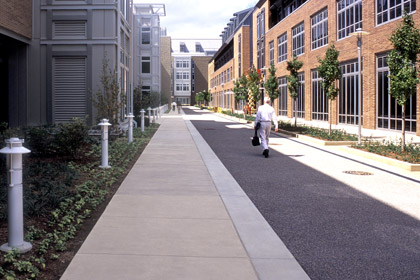 The process required long hours by staff, but the Township approved only three variances for the entire project. This attests to the role of planning in economic development, and how comprehensive planning provides a framework for communities to prosper.
The process required long hours by staff, but the Township approved only three variances for the entire project. This attests to the role of planning in economic development, and how comprehensive planning provides a framework for communities to prosper.
While it is not clear how many of the employees will move to the Township as residents, impacts are already being felt. Visteon employees have volunteered at a playground refurbishing, and the corporation has partnered with the Township to create a civic fund. Visteon’s initial $1 million pledge is envisioned to be the beginning of a larger relationship with other community employers to work together on community projects and programs.
[1] Tom Murphy, “ Visteon Settles In,” Ward's Auto World, 1 February 2005 http://waw.wardsauto.com/ar/auto_visteon_settles/.
[2]
Visteon Corporation Fact Sheet, http://www.visteon.com/newsroom/press_kits/village_facts2.shtml.
[3]
Ibid.
[4]
Gerald LaVaute, “Tax incentives lured Visteon,” The View, 18 December 2003http://www.bellevilleview.com/stories/121803/loc_20031218003.shtml.
[5]
Gerald LaVaute, “What changes could Visteon bring to area?,” The View, 11 December 2003 http://www.bellevilleview.com/stories/121103/loc_20031211003.shtml.
[6]
Presentation at Michigan Society of Planning 2004 Annual Conference, “How to Attract and Win a High Impact Project: Jobs, Image, and Tax Base,” 30 September 2004, courtesy of McKenna Associates.
[7]
Ibid.
[8]
Bryce Kelley, Van Buren Township Planning and Economic Development Director, interviewed by the author, 30 March 2005.
[9]
Business Briefs, The View, 23 October 2003 http://archives.heritage.com/bv/20031023/V08BJAB.htm.
[10]
LaVaute, “Tax incentives lured Visteon,” The View, 18 December 2003.
[11]
Michigan Economic Development Corporation, http://medc.michigan.org/common/book/main.asp?BookId=4&BookName=Community+Guide&ChapName=Local+Development+Financing+Authority+%28LDFA%29&ChapId=75&m=12;4 .
[12]
Michigan Economic Development Corporation, http://medc.michigan.org/common/book/topic.asp?BookId=4&BookName=Community+Guide&ChapName=Local+Development+Financing+Authority+%28LDFA%29&ChapId=75&TopicId=319&TopicContent={DBB8C6A7-BC0B-47FE-B20A-197E82A3E39F}&m=12;4.
[13]
Jamie Banas, “ Township moves ahead with Visteon project,” The View, 13 March 2003 http://archives.heritage.com/bv/20030313/V02IJAB.htm.
[14]
Kelley interview, 30 March 2005.
[15]
Banas, “ Township moves ahead with Visteon project,” The View, 13 March 2003.
[16]
Visteon Corporation Press Release, “ Preserving the Environment a Top Priority at Visteon Village,” http://www.visteon.com/newsroom/press/2004/080604d.shtml.
[17]
Murphy, “ Visteon Settles In,” Ward's Auto World, 1 February 2005.
[18]
Ibid.
[19]
InternetAutoGuide.com, “ Visteon Village Design Fosters Collaboration and Innovative Thinking,” 6 August 2004 http://www.internetautoguide.com/auto-news/25-int/6146/.
[20]
Murphy, “ Visteon Settles In,” Ward's Auto World, 1 February 2005.
[21]
InternetAutoGuide.com, “ Visteon Village Design Fosters Collaboration and Innovative Thinking,” 6 August 2004.
[22]
Heritage Newspapers, “ Future looking bright for Visteon,” The View, 29 May 2003.
[23]
Kelley interview, 30 March 2005.
[24]
Visteon Corporation Press Release, “ Preserving the Environment a Top Priority at Visteon Village.”
[25]
Ibid.